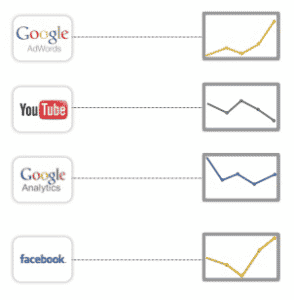In this November Simple Talk article by Robert Sheldon, he discusses an on-coming wave of “data as a service” (DaaS) which is meeting the growing demand for companies to use more data to make decisions. We agree that the wave is coming – we’re riding it – especially in the marketing space. CEOs and owners are aware that there’s more available data than there’s ever been. Thus, agencies and marketing departments are under more pressure to be accountable for their decisions.
When beginning your search for a DaaS solution, it’s important to understand what it truly means to build a single source of marketing truth. Can you see how all of your marketing channels work together to bring about all of your interest? Do you know how to correctly allocate costs to best performing channels? Do you know how many visits to your website it will take to get you to the number of conversions you want? How many conversions does it take to get you a transaction?
Here are 5 things to think about when choosing a solution to answer these questions:
1. Do you get full ownership and control of the data?
Sometimes service providers will collect your data for you, and supply you with reporting tools to analyze it, but that doesn’t mean the data is in an environment that you can access, or that it will even be in a format for you to support other modeling or analytical endeavors. Make sure your service provider gives you full control over your data in its newly connected format.
2. Does the solution accept all of your data?
When wading through your options, you’ll often see vendors telling you they have a comprehensive collection of data sources. This is probably true, but sometimes vendors will restrict you to a pre-ordained library of existing connections, meaning what you see is what you get. Good vendors will agree to connect to any data source, in any data format. Marketing intelligence is in knowing the true meaning of performance, from creating awareness to driving sales. This can mean, for example, seeing impressions from those sexy API connections work with uglier data in spreadsheets from legacy accounting systems. Make sure your Data as a Service provider actually accepts all of the data in your particular data ecosystem.
3. Does it work with your internal systems?
Much of the time, you’re already doing some analysis yourself. You’re building dashboards with a reporting tool like Tableau Software or Bime, and burning your other resources on actually getting the data into a format ready for that analysis. Some vendors are an ‘all in one’ type of service, which means that later into negotiations, they’ll ask you to jettison existing processes in favor of their package deal. For example, you may want to perform analysis with your existing dashboarding tool, and just want a data platform to solve your data problem. Don’t pay more to duplicate the part of your process that’s already working — find a data solution that can be customized to take away the burden where there actually is one.
4. Is the data actually being aggregated?

As good as this all sounds, however, DaaS is not without its challenges. It’s no small task integrating data from disparate sources, de-duplicating and cleansing the data, adding value to the data, and presenting the data as an open SOA service. Data might come from relational databases, Hadoop clusters, data warehouses, social media sites, news feeds, mobile devices, or any number of heterogeneous sources. Regardless of the variety of sources, however, the data must be presented as a unified, comprehensive resource that is reliable in terms of accuracy and availability—and the more data grows in size and complexity, the harder the job becomes.
We agree. The majority of solutions on the market today just bring you live connections to data without doing the work to get those sources to talk to each other. This doesn’t break down data silos – it just takes all of your silos and puts them next to each other. For example, your CMO may want to know how a particular multichannel campaign worked across radio, television, email, and the web. Just being connected to all of those things doesn’t mean you have an actively managed data warehouse threading those mediums into one view. Look for vendors that advertise a ‘human’ element with their data services. Invest in people with a platform – it will take a real team of dedicated professionals to customize your dataset with your goals in mind, and give you intelligence that’s ready for real analysis and modeling.
5. Is the data actually being cleansed?
This is another area where an actively managed data warehouse is crucial. When campaigns, objectives, and keywords are working across different mediums, and those mediums are handled by different people, consistency can be an issue. Make sure your data provider bakes this element into your plan – they’ll catch mistakes, and save you money by working with you to normalize campaign identification as well as other data points particular to your implementation.